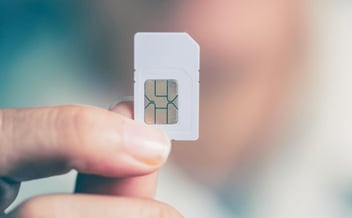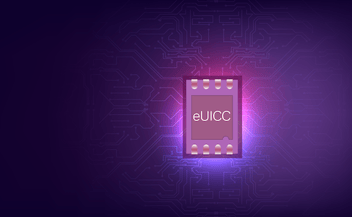

eSIM vs iSIM: What are the differences?
Do you know the differences between eSIM and iSIM? Both of them are important for various applications, and we must understand what they are, and how they are used.
Getting to know eSIM
An eSIM, or embedded SIM refers to a digital SIM card that is built into a device, a soldered component that doesn’t have to be inserted or ejected from a device. eSIM as an embedded SIM can be preloaded with the network carrier profiles.
An eSIM can also refer to an Embedded Universal Integrated Circuit Card (eUICC) that can be remotely programmed and configured for new network carrier profiles.
When eSIM is referred to as eUICC, users can change carriers and plans without physically changing the SIM card. Therefore, this makes it convenient for devices to manage multiple network connections.
In this article, we will be indicating when we will be referring to one or the other by using eSIM (embedded SIM) and eSIM (eUICC).
eSIM technology is widely used for M2M (Machine-to-Machine) devices because of its convenience, flexibility, and remote management capabilities.
Introducing iSIM
An iSIM is a SIM integrated in a system-on-chip(SoC), typically as a secure enclave containing a SIM OS and an MNO profile.. It differs from regular SIM cards, which can be taken out, or MFF2 SIM cards that need to be soldered and connected to the device's main chipset. Instead, the iSIM is permanently integrated into the device's chipset.
An iSIM may also be known as an iUICC, and it may incorporate eUICC functionalities into a System on a Chip (SoC), allowing for the installation of Mobile Network Operator (MNO) profiles at the time of SoC production, IoT device creation, or in the field.
iSIM technology offers advantages in security, space-saving design and stability. It is ideal for certain use cases where security and durability are crucial and commonly used in industrial and critical applications.
What are the differences between an eSIM and iSIM?
eSIM and iSIM are variations of traditional SIM technology designed to offer more flexibility and convenience in managing mobile connectivity.
When comparing eSIM and iSIM as embedded SIM vs integrated SIM, the major differences are as below:
Presence in device: An eSIM, when referring to the form factor, is a physical SIM card soldered or embedded into a device and is visible as a different element. Whereas, an iSIM as an integrated SIM is directly integrated into the device's chipset and is not physically visible.
Physical Space: An eSIM as an embedded SIM, while smaller, still occupies a physical space within a device. On the other hand, iSIMs offer a space-saving design, eliminating the need for a physical SIM card slot or a soldered MFF2 chip and internal connection lines to the main chipset.
When comparing eSIM and iSIM as eUICC and iUICC, since iSIM can also make use of the eUICC technology, it is difficult to compare the two, as there are no key differences between them.
When it comes to use cases, eSIM technology greatly facilitates M2M connectivity, which can be used in mobile devices and device management while being more dynamic and affordable. iSIMs are generally used in more specialised applications and devices. For example, industrial IoT devices, smart grid devices, satellite communication terminals, and critical infrastructure systems.
Benefits and Limitations of eSIM and iSIM
Both eSIMs and iSIMs have their own upsides and limitations. Therefore, the choice between eSIM and iSIM depends on the device's intended use, security requirements, the level of flexibility and permanence needed, and your application’s use case.
Benefits of eSIM:
- Convenience: eSIMs(eUICCs) can be provisioned, activated, and managed remotely, offering the flexibility to switch carriers without replacing a physical SIM card. It makes device activation and management more convenient.
- Reduced Physical Space: eSIMs (embedded SIM) are valuable for smaller and thinner M2M devices like sensors/ trackers, smart meters, wearables, etc, because they occupy less physical space within devices.
- Multiple Profiles: A single eSIM (eUICC) can support multiple carrier profiles, enabling the switch between profiles and plans quickly.
- Remote Security: eSIMs (eUICCs) support remote security management features through encrypted channels.
Limitation of eSIM:
- Limited Availability: Currently, not all devices and network carriers support eSIMs (eUICCs). It limits the widespread adoption of eSIM technology at the moment.
- Compatibility issues: The utility of eSIMs (eUICCs) can be optimised by the correct configuration between the mobile carriers and device manufacturers. If they are not coordinated, it can lead to compatibility issues.
- Switching Vendors is complex: When you switch to a new connectivity vendor for M2M eSIM, you have to move the device configurations and their security keys to the new system. This process, called SM-SR swap, is quite tricky and can be expensive for both the network provider and the IoT business.
Benefits of iSIM:
- Tightened Security: Because the iSIMs are integrated into a device's hardware, they provide a high level of security against tampering and unauthorised access.
- Space efficient: iSIMs eliminate the need for a physical space in its entirety, which is valuable for devices with limited space.
- Permanence: iSIMs are integrated during manufacturing and cannot be removed, providing long-term stability and security.
Limitation of iSIM:
- Limited Flexibility: Swapping or upgrading iSIM is difficult compared to embedded SIM because it's fused onto the chipset. If an iSIM is faulty, the device might require replacement or repair. In this scenario, switching network operators or SIM profiles might only be possible by changing the chipset.
- Limited industry adoption: As of now, the iSIMs have yet to be widely adopted, especially for consumer devices. They are often used in more specialised and complex industrial applications.
- Cost and Complexity: Integrating iSIM technology into devices can add to manufacturing costs and complexity, potentially limiting its adoption in cost-sensitive markets.
Speak to a Velos IoT expert
Related articles


SIM profile management – linear or circular?

Digging deeper into eSIM: how do expectations meet reality?
The eSIM has been coined the next generation of the SIM card. Its uses are vast and varied, and...